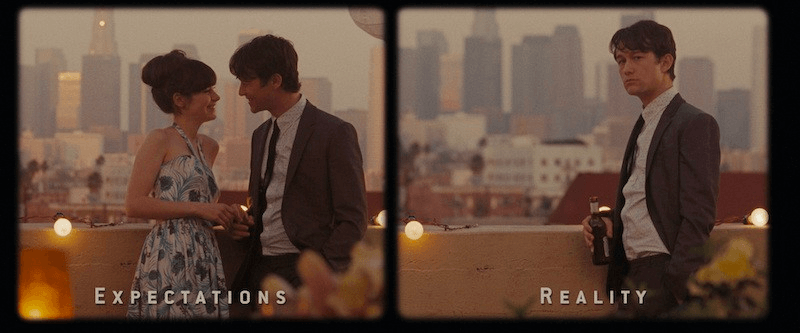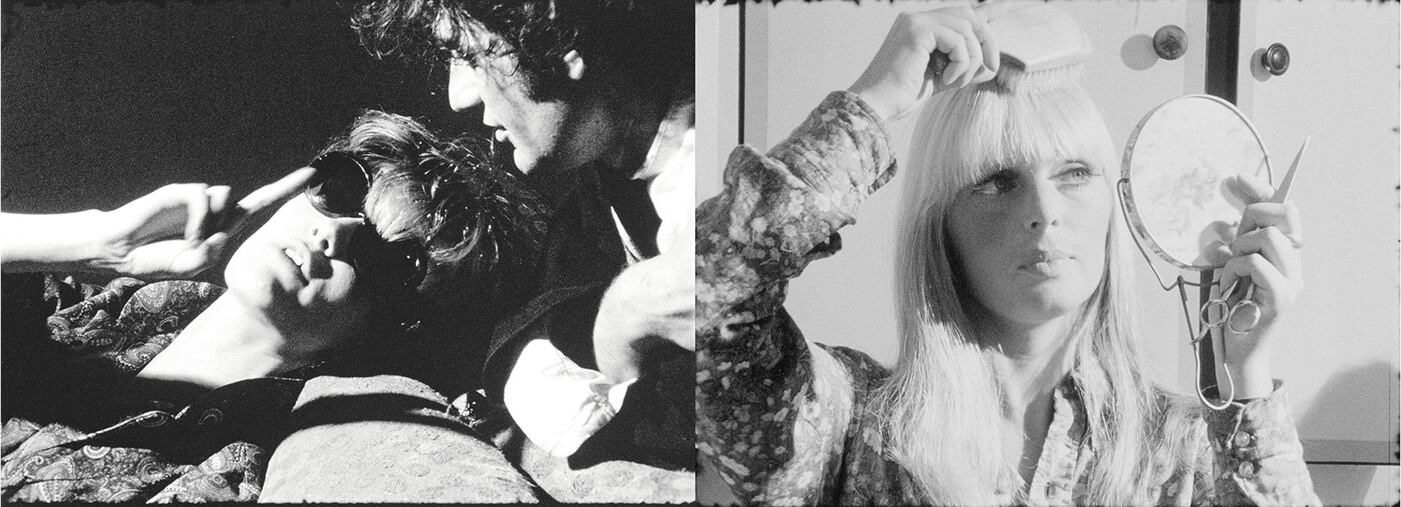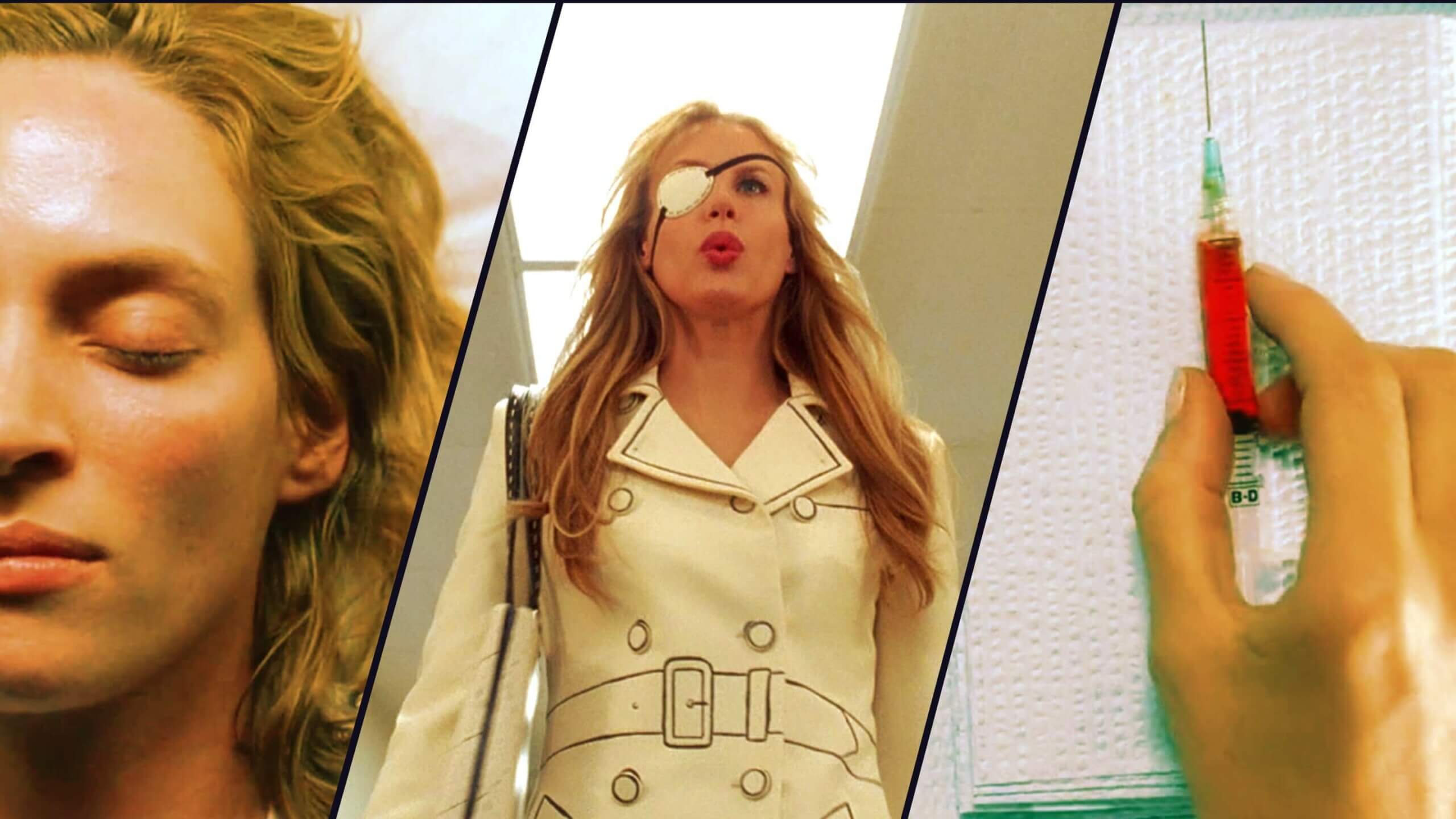A split screen immediately draws attention to itself. It’s a technique which signals a certain stylization and, by its very nature, divides our attention between multiple frames. Because of this, split screens are often used sparingly. And yet, when used well, they can create some instantly-iconic juxtapositions that elevate a story. Here are some of the finest split screen film examples ranked.
Split Screen Film Examples
10. Carrie (1976)
Carrie movie split screen
Brian De Palma loves a good split screen. He uses them in Dressed to Kill and Sisters to great effect, but his most memorable split screen is in Carrie.
With Carrie’s climactic scene, De Palma created a classic piece of horror iconography – everyone knows the image of Carrie doused in blood. But what makes the scene all the more dynamic is its use of split screen.
As De Palma holds a close-up on Carrie’s face, we see doors closing and her tormentors beginning to panic. As such, De Palma is able to center Carrie in the moment while also highlighting her powers.
The split screen also adds to the chaotic mania of the scene. We’re able to watch different elements of the prom descend into madness simultaneously.
De Palma’s formal techniques make this scene an unforgettable one.
Split Screen Film Examples
9. 500 Days of Summer (2009)
500 Days of Summer expectations and reality
(500) Days of Summer’s use of split screen is driven by one simple idea: expectations vs. reality. We’ve all experienced the heartbreak of having unchecked expectations get crushed by what actually happens. It’s all the more heartbreaking when it’s in a romantic context.
Tom had very specific ideas about how seeing Summer would go, and none of it comes to fruition. Instead of having him say this in dialogue, or telling us in voice over, director Marc Webb opts for putting the two visions side by side and letting them speak for themselves.
Here's our video breakdown of the scene:
How to direct two screens and scenes at once
It’s executed with great editing to maintain the timing of each beat. Smartly, the beats are staggered; we see the expectation, then we see the reality. This lets the audience take in each side one at a time while still directly contrasting them. The ingenious use of split screen makes culminates in the quintessential Sad Boy visual:

Split screen
Millions of Tumblr blogs were never the same.
Split Screen Film Examples
8. Adaptation (2002)
Adaptation movie split screen
Are you racking your brain, trying to remember the split screen scene in Adaptation? That’s because Adaptation utilizes an invisible split screen. It’s used to allow Nicholas Cage to play both Charlie and Donald in Spike Jonze and Charlie Kaufman’s oddball comedy.
The invisible split screen divides a frame between two takes, one where Cage is Charlie, and one where he’s Donald. It earns a place on this list because it’s so perfectly pulled off. The timing, crucial for a comedy, is spot-on, and Cage delivers a career-best performance as both characters.
In the above scene, Kaufman hints at the split screen at play (fitting for how meta Adaptation is). Donald refers to trick photography, and Charlie references Dressed to Kill, which employs split screens all over the place.
There are few examples of invisible split screens as good as this.
Split Screen Film Examples
7. Conversations with Other Women (2005)
Conversations with other Women
Conversations with Other Women is presented entirely in split screen. But it’s not just a gimmick: director Hans Canosa uses the technique to show the differing perspectives of both people in a relationship.
Through split screen, we see how each character perceives the other, giving us empathy for both sides.
But the technique also allows for innovative compositions.
Take the following scene:
Conversations with Other Women scene
This scene could have easily been captured in a medium two shot, since both characters are presumably standing next to each other. But the use of split screen here allows for Canosa to get close ups on both characters, displaying the intricacy of their emotions, while also creating a manufactured distance between them.
Canosa edited the film himself, and deciding to go for a split screen that lasts the entire runtime is a bold move. Unfortunately, DVD and Blu-ray versions have done away with most of the split screen.
But for the most part, it feels deliberate and earned.
Split Screen Film Examples
6. Annie Hall (1977)
Annie Hall
As you’re beginning to see, romantic comedies love a good split screen. So it should come as no surprise that one of the most celebrated and influential romcoms ever also has one of the best split screen scenes.
The split screen therapy scene in Annie Hall is a perfect explanation for why split screens proliferate in romcoms. Here, Annie and Alvie see their respective shrinks and discuss their relationship. Humor is found in the discrepancies of their views on their love life; romcoms in a nutshell.
Diane Keaton and Woody Allen are able to nail the comedic timing of the scene because the split screen was physically created: the therapist office sets were built right next to each other.
This may be the most memorable split screen from Hall, but there’s another great one as well:
Annie Hall dinner scene
Here, it’s used to compare and contrast. It’s inventive, visual comedy.
Split Screen Movies
5. When Harry Met Sally (1989)
When Harry Met Sally split screen phone call
Yep, another romantic comedy. But whereas most of the romcom split screens we’ve shown so far highlight characters’ differences, When Harry Met Sally beautifully uses the technique to create intimacy.
When Harry Met Sally is the greatest cinematic depiction of the ties between love and friendship, and this scene shows us why.
It’s a low-stakes sequence – just two friends chatting over the phone. But the split screen puts the characters, who are miles away, in the same bed. It makes the conversation feel like pillow talk, and strengthens the connection between Harry and Sally.
The result is a heartwarming scene that shows us a split screen doesn’t need to be over-the-top to be powerful.
Split Screen Movies
4. Timecode (2000)
Split screen examples film
Like Conversations with Other Women, Timecode maintains its split screen for its entire runtime. This film, however, displays four frames simultaneously.
Timecode lands this high on our list because of just how difficult it is to pull off. Director Mike Figgis decided to have each frame be one, continuous shot, meaning the pacing is even trickier to nail.
He also needed to direct an audience’s attention without allowing one frame to take up the whole frame. To do this, Figgis would create emphasis through sound. If one frame has the most important plot point, that’s the frame we hear the clearest.
As the trailer illustrates, the split screen creates a feeling of surveillance. We know what each character is doing when the focus normally wouldn’t be on them. Ever wondered what a character does when a scene ends? This is the movie for you.
What is Split Screen
3. Hulk (2003)
Hulk
Hulk was one of the first stabs at revitalizing Marvel’s film presence. It was totally eclipsed by Sam Raimi’s Spider-Man, and as such, it represents a path not taken. With Hulk, director Ang Lee created a film that mimicked the feeling of a comic book.
To do this, Lee employs split screens throughout the movie, so that forms operate as comic panels. Different pieces of visual information are consumed almost simultaneously. It gives the film a distinct look, and allows for some fantastic, economic storytelling.
This hyper-stylized editing somehow doesn’t push the film in a campy direction. The pacing of Hulk stays nearly meditative; the movie is one of the quietest superhero flicks ever. It’s a contradiction only Ang Lee could pull off.
The majority of Marvel movies that came after may not have followed in Hulk’s footsteps, but arguably the most exciting Marvel entry in recent years has: Hulk smashed so the Spider-Man: Into the Spider-Verse series could swing.
What is Split Screen
2. Indiscreet (1958)
Indiscreet split screen filming
In all likelihood, Indiscreet is to blame for the proliferation of split screens in romantic comedies. Perhaps that’s because it’s so well done.
Like Harry Met Sally (which almost certainly borrows from this scene), Indiscreet shows the two romantic leads lying in bed. They trade a flirtatious and witty conversation, and the tension is palpable– it’s Cary Grant and Ingrid Bergman at the peak of their powers.
The camera angle of Indiscreet, however, is far more suggestive than Harry Met Sally. It’s a bit higher, and clearly is meant to make it seem as though they are in the same bed.
In this way, Indiscreet shows the ingenuity of filmmakers during the Hays Code. One rule outlined by the Code was that an unmarried couple couldn’t be shown in the same bed. Director Stanley Donan subverts the rule with a well-placed and well-planned split screen.
Split Screen Filming
1. Chelsea Girls (1966)
Andy Warhol’s finest film
It’s no secret that Andy Warhol was a boundary-pushing artist. His films were not an exception to the rule, and his 1966 Chelsea Girls is his crowning filmic achievement.
Anyone familiar with Warhol’s paintings knows that the visionary was fond of paneling, and so it should come as no surprise that Chelsea Girls makes stellar use of this in a cinematic context. The film boasts a three-and-a-half hour long splitscreen, the entire runtime.
The film was a pioneering look into the New York underground scene of the time, a far cry from what was being shown in mainstream Hollywood at the time (remember, Indiscreet came out just eight years earlier). Split screen allowed Warhol to more fully capture the energy of a place like the Chelsea Hotel, where a million things were happening at once.

The Chelsea Hotel in all its glory
This allows the viewer a certain sense of control. As you watch the film, you can choose which frame you want to pay more attention to, unlike many of the examples we’ve looked at so far which direct the viewer's eye.
The sheer length of the split screen allows for more spontaneity. Originally, Warhol let projectionists decide how they wanted to arrange the reels of film they were given to screen. But even in its set form, the split screen allows for a blend of scripted and unscripted. Threads unravel and tie up at random, and if you blink you might miss them.
It’s a fitting technique for an avant-garde artist, and perhaps the only way to do justice to the hugely important community living in the margins of New York. Chelsea Girls is everything you want in a split screen: innovative, in service of the film, and gorgeously realized.
UP NEXT
Cross Cutting and Parallel Editing
Now that you know all the best split screen film examples (just kidding, there’s a million more), time to look at another couple editing methods. Cross cutting and parallel editing can often have a similar effect as a split screen, but achieved differently. We explain what the techniques are, and what differentiates them.
Up Next: Cross Cutting and Parallel Editing Explained →
Showcase your vision with elegant shot lists and storyboards.
Create robust and customizable shot lists. Upload images to make storyboards and slideshows.
